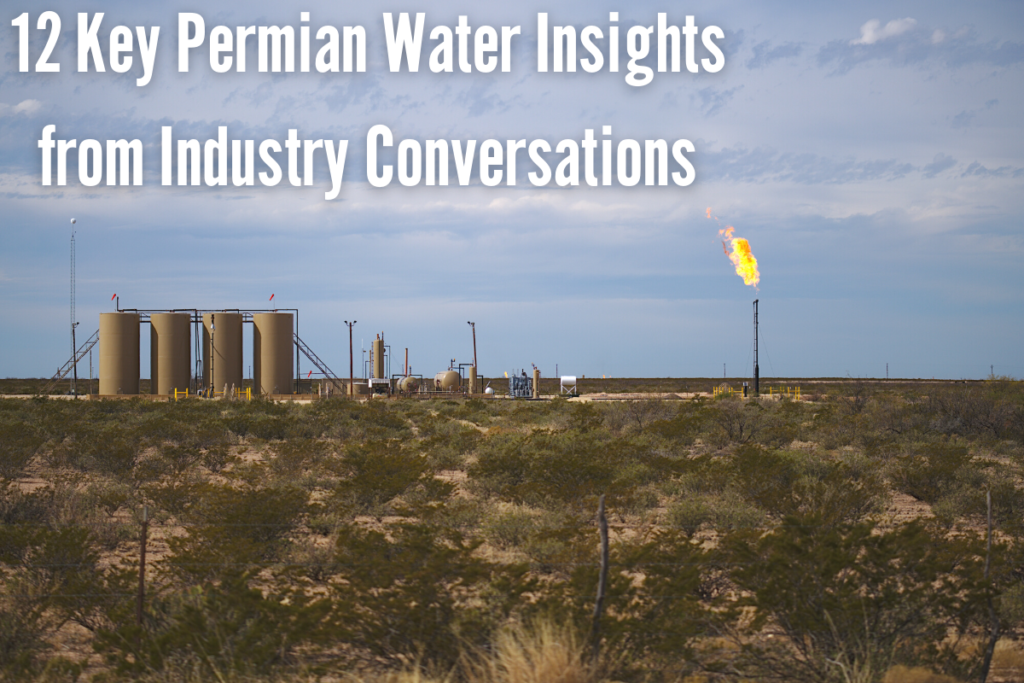By Kylie Wright
Many recent industry conversations have reflected the constantly shifting economic and regulatory landscape impacting the Oil and Gas and Oilfield Water Industries. It’s amazing to us that B3 has been to a half-dozen conferences in the past few weeks and some of the prevailing topics have dramatically shifted just in that short period of time.
What’s on our mind
On March 9th, B3 hosted our annual Ripple Effects Summit prior to the Oilfield Water Connection’s Water Markets Conference in Dallas. This is the second year B3 facilitated a conversation among industry leaders and we’re grateful for our many wonderful attendees and supporters.
A few important insights and sentiments emerged from our Ripple Effects and Oilfield Water Connection conversations.
- Producers are gearing up to bridge the production gap left by the US ban on Russian oil imports, thereby increasing the amount of water to be managed in the Permian.
- Producers are concerned about seismicity and feel that an increase in produced water volume combined with the lack of viable, non-disposal management options will make seismicity worse before it gets better.
- All parties feel that the industry will face additional, stringent seismicity regulations (Seismic Response Areas or SRAs) over the coming months and years.
- Disposal capacity has been, and will continue to be, reduced due to the SRAs.
- Disposal capacity solutions may involve developing infrastructure able to move water outside of SRAs and other seismically risky areas at a large scale or sharing existing infrastructure to optimize available disposal capacity.
- Increasing oilfield recycling of produced water has been a mid-term goal for the industry, but the SRAs have shifted increased oilfield recycling to a near-term priority.
- Recycling, even if greatly increased, will not account for a large enough portion of produced water management to eliminate the need for more disposal wells.
- Producers are refocusing their attention on internal water management to ensure they have a full understanding of their operations’ impact on seismicity.
- Finance appears to be increasingly interested in technology and service providers thinking beyond oil and gas applications of their products.
- Beneficial reuse as a significant outlet for produced water is still years in the future.
- It is difficult for finance to assign value to ESG reporting right now because the information captured in disclosure is too disparate and hard to tie to financial materiality.
- Seismicity is overshadowing other ongoing, important industry issues.
Being nimble in a time of seismicity
As we’ve all become accustomed to, conversations at both conferences were largely focused on the disposal capacity in the Permian changing because of seismicity regulations. What is unexpected, however, is that as producers wrap their arms around these new regulations, they seem to be leveraging more internal resources to manage produced water. Some of this reaction is likely due to the unpredictable nature of seismicity. Producers are working to decrease their reaction time to changes in disposal capacity and infrastructure availability by initiating more communication between internal company groups. There is a sentiment among producers that critical challenges are better solved by the producers themselves; E&Ps would rather be part of developing the solution than wait for third parties or state regulators to come up with a solution for them. If that’s the case, does the industry risk missing an opportunity to leverage a captive market of service companies eager to invest in a solution?
Frequently, these conversations are multi-faceted, with numerous, valid angles and approaches. Seismicity regulations have also identified the opportunity for additional partnerships to enhance infrastructure sharing and optimize disposal and reuse networks to ensure that produced water management does not prevent the successful production of oil and gas. Many groups are interested in investing in new technology solutions and developing new capital relationships to build long-haul infrastructure and new storage capacity. Landowners are an important partner to integrate into these discussions to ensure that the industry can find collaborative solutions for all.

ADDITIONAL CONSIDERATIONS
Alongside seismicity, numerous other factors came up as concerns, including increasing oil and gas (and water) production to bridge recent impacts to global supply. Increasing produced water volume in the Permian is not unexpected but is concerning when considering recent capacity reductions in existing disposal wells and the management shortfall left even if recycling is increased to 100%. Not to mention that increasing water treatment for oilfield or non-oilfield reuse will result in a significant increase in solid, sometimes hazardous, waste requiring storage and disposal. Companies are more aggressively exploring beneficial reuse options, but the consensus remains that the viability of this option is still many years away. The industry must engage in some serious self-reflection to determine whether companies are ready to invest proactively in ideas rather than reactively to constraints. When considered in aggregate, the message is clear for now that disposal will remain the primary water management option in the Permian for years to come.
In our view, combining these factors leads to one eventuality: water management will become more expensive as companies are forced to leap technological and logistical water managment hurdles standing in the way of oil and gas production. These industry factors will continue to evolve over the coming months, causing conversations to shift and operations to adapt. B3 is proud to facilitate the kind of intimate conversations that clarify the real issues, sentiments, and solutions to ensure energy production and water stewardship. Join us next year for Ripple Effects and Oilfield Water Markets 2023!
Empowering Smart Water Management
B3 Insight is building the definitive source for water data. We empower smart water management with data-driven intelligence for responsible and profitable decisions about water resources. Whatever your needs, B3 Insight’s OilfieldH2O can positively impact your water management and drilling completions – contact us at [email protected] or 720-664-8517 to learn more.





